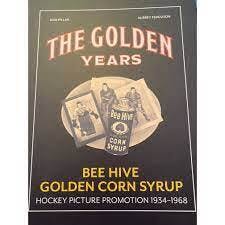
Book Review
The Golden Years: Bee Hive Golden Corn Syrup Hockey Picture Promotion, 1934-1968, 2020
By Don Pillar and Aubrey Ferguson
For those of us who spent a good chunk of our youth obsessed with collecting, trading and gambling hockey cards, Don Pillar and Aubrey Ferguson have published an ode to our erstwhile passion. The Golden Years: Bee Hive Golden Corn Syrup Hockey Picture Promotion, 1934- 1968, chronicles a marketing campaign that the authors describe as having been “the most successful consumer promotion in Canadian history”, (Preface). This is definitely not an academic treatment of the subject, but this coffee-table book makes for a welcome distraction from the daily case counts and colour-zone updates that define our world during these socially- distanced times.
Pillar and Ferguson trace practically every detail of this consumer promotion that was thoroughly Canadian. There is nothing more Canuck than a successful nineteenth century business – in this case the St. Lawrence Starch Company, based in Port Credit, Ontario – that was founded by two transplanted Scottish entrepreneurs. Established in 1889, the firm’s major product was initially starch but soon became corn syrup, and the company adopted the name Bee Hive to connote it with nature even though it was manufactured in a factory. The adjective Golden was added to distinguish it from St. Lawrence Starch’s clear syrup. To help the firm increase sales in the early years of the Depression, it engaged McConnell & Ferguson, an advertising agency in Toronto. The upshot saw St. Lawrence Starch begin sponsoring a sports program on CFRB, the Queen City’s pioneering radio station, in 1933 and launching its hockey picture promotion the next year; the latter continued for four decades. The authors point out that the company’s commitment to this marketing campaign is so noteworthy because this “endearing and enduring promotion was offered by a relatively low profile, Canadian-owned, food processing company not known for their marketing prowess and large marketing budget”, (iii).
Several features distinguished this marketing project. Unlike buying hockey cards at the five- and-dime, whereby each pack contained a random assortment of players, the Bee Hive promotion entailed consumers submitting the requisite number of labels from the company’s products and ordering the specific player whose picture they wished to receive. The company invested a truly extraordinary amount of money to administer the promotion during its thirty-five year run. During that span, the top floor of the firm’s administration building housed the staff – the “Bee Hive Ladies” – and the inventory of hockey pictures. At its peak, eleven women worked at verifying that each request was in order, addressing the envelopes and filling them with the requested photos, and sending out an estimated 2,500 pictures each day.
In tracing the promotion’s history, the authors effectively link its success and decline to broader trends in Canadian history. It was launched just as radio broadcasting was taking off, and through the new medium Foster Hewitt’s Hockey Night in Canada almost instantly became one of the bonds that linked Canadians from coast to coast. Bee Hive’s hockey pictures thus became the “visual component to radio broadcasts of NHL hockey games”, (170). Paper rationing forced the company to suspend its promotion during the Second World War. While it resumed thereafter, the early 1950s saw the advent of television, and within a decade nearly every home in Canada had one. Hockey fans could now for the first time witness with their own eyes their favourite players in action, thus undermining the role that Bee Hive hockey pictures had previously played. The promotion’s death knell was sounded when Conn Smythe sold in 1961 his controlling interest in the Toronto Maple Leafs, the team that had dominated Bee Hive hockey pictures since their inception. Within a few years and amidst the growing commercialization of professional sports, the new owners insisted that St. Lawrence Starch pay market prices for the right to use images of Leafs’ players. The company reacted by cutting the promotion’s costs, and then terminating it in 1967-68.
Pillar and Ferguson openly admit that they were fanatical collectors of Bee Hive hockey pictures, and their book attests to their devotion. Undoubtedly, some readers will be frustrated by the authors’ decision to reproduce practically every hockey picture that the company published and every reference to the promotion they could find. By the same token, their story is woven together by the major themes that marked Canadian business, media, advertising and food history during the middle third of the twentieth century. In addition, a few of the anecdotes that the authors convey about the promotion are truly golden and highlight how times sure have changed. In the late 1930s, for example, Leafs’ superstar Gordie Drillon – the Phil Esposito of his day – received a small cash payment ($25) and a case of syrup in exchange for allowing Honey Bee to use his photo. He had to pay to ship the latter to his mother in New Brunswick, however, so the $16.50 he spent on postage meant that he barely broke even on the deal, (68).
Mark Kuhlberg
Laurentian University